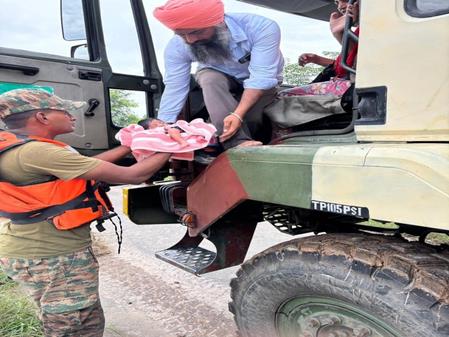Army Rescues 5,000 Civilians, 300 Paramilitary Personnel From Flood-Hit Punjab, Himachal & Jammu
Also, approximately 21 tonnes of relief material, including food packets, medicines, and essential commodities, have been delivered on ground and through aerial drops to cut-off villages.
The Western Command launched extensive flood relief and rescue operations on August 16-17 and an assessment of the developing flood situation was taken, with troops, engineers, medical detachments, and aviation assets mobilised at short notice to safeguard lives and restore essential services.
It said flood relief columns were fully prepared, trained, and equipped to undertake Humanitarian Assistance and Disaster Relief (HADR) missions. On receiving requisitions from the civil administration, these columns were swiftly deployed across affected areas.
Aviation assets, both of Indian Army Aviation and further supported by the Indian Air Force, have been flying sustained sorties, ensuring timely evacuation of stranded civilians and aerial delivery of critical supplies.
A flood control and water level monitoring cell has been established, functioning round-the-clock to monitor water levels across major headworks, including the Bhakra-Nangal Dam, the Ranjit Sagar Dam, and other critical points.
Operations are being conducted in close coordination with the civil administration, the NDRF, and the SDRF.
“This integrated approach has ensured optimal use of resources and timely assistance to affected populations, reflecting the nation's resilience and unity during crises. This proactive measure has enabled timely deployment and response to emerging threats,” it said.
A total of 47 Army columns have been mobilised, comprising personnel from engineers, medical detachments and communication teams, in addition to the main rescue teams.
Twenty aircraft, including Advanced Light Helicopters, Reconnaissance and Observation helicopters, Mi-17s, and a Chinook, are engaged in round-the-clock missions and have flown over 250 hours so far.
On August 27, communication teams laid more than two km of optical fibre cable, restoring mobile connectivity and enabling smooth coordination of relief measures.
Subsequently, Army engineers constructed a Bailey Bridge at Jammu Tawi within 12 hours on August 29, restoring a vital lifeline for the city.
There were challenges wherein the enclaves along the Ravi and Chenab rivers had got inundated. This is the area between the river and border fence.
Hence, own troops including Border Security Force (BSF) personnel and civilians in inundated villages were evacuated leaving behind adequate strength to ensure security of the area.

Legal Disclaimer:
MENAFN provides the
information “as is” without warranty of any kind. We do not accept
any responsibility or liability for the accuracy, content, images,
videos, licenses, completeness, legality, or reliability of the information
contained in this article. If you have any complaints or copyright
issues related to this article, kindly contact the provider above.
Most popular stories
Market Research

- UK Cosmetics And Personal Care Market To Reach USD 23.2 Billion By 2033
- Global Mobile Wallet Market Size Projected To Reach USD 701.0 Billion By 2033 CAGR Of 15.09%.
- $MBG Token Supply Reduced By 4.86M In First Buyback And Burn By Multibank Group
- From Zero To Crypto Hero In 25 Minutes: Changelly Introduces A Free Gamified Crash Course
- Japan Halal Food Market Size To Surpass USD 323.6 Billion By 2033 With A CAGR Of 8.1%
- Pluscapital Advisor Empowers Traders To Master Global Markets Around The Clock




















Comments
No comment